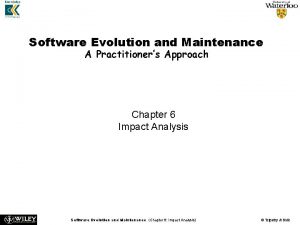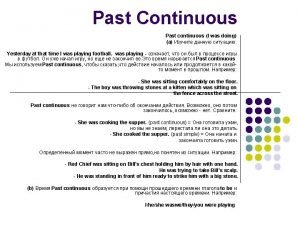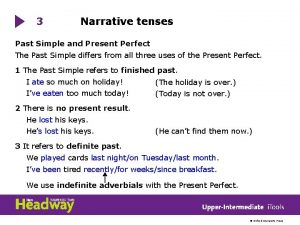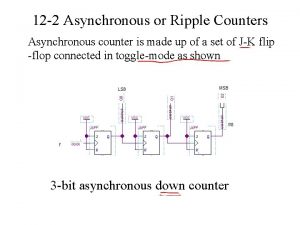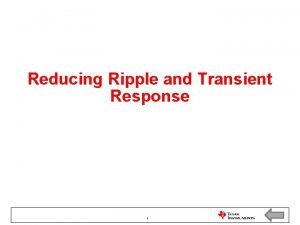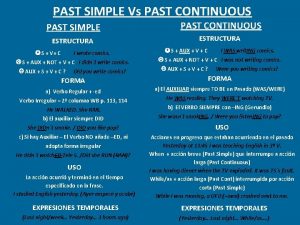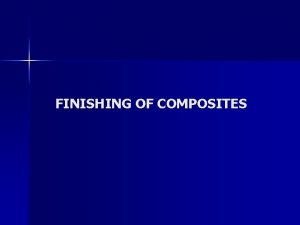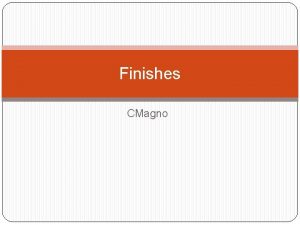The Ripple Effect 1694 2009 Finishing The Past

























- Slides: 25

The Ripple Effect 1694– 2009: Finishing The Past By Lowell Manning

The Ripple Starts Here 1694– 2009: Finishing The Past Hi, I’m Lowell Manning Please join me in this short trip inside our debt-based financial system • Keynesianism and Monetarism have both failed because neither of them takes account of the mechanics of the debt system itself • This work proposes to replace them with an economic debt model that takes into account the mechanics of interest-bearing debt

Fisher’s Equation of Exchange Irving Fisher proposed his equation of exchange in 1911: MV = PQ M V P Q = = money supply speed of circulation of the money M price level quantity of goods and services produced In Fisher’s day the terms were hard to quantify – that didn’t get any easier until now V is essentially a hoarding function

The Visual Challenge Consumer Price Index: England 1300– 2000 CPI 50, 000 45, 000 40, 000 35, 000 30, 000 25, 000 20, 000 Fisher Equation 1911 MV=PQ 15, 000 10, 000 5, 000 0 Base year 1300 = 100 1350 1400 1450 1500 1550 1600 1650 1700 1750 1800 1850 1900 1950 2000 Year Are we to blame M or V?

Bank of England 1694 Perpetual Interest-Bearing Debt Perpetual debt is unproductive and permanent Unearned interest income

Unearned Interest The unearned interest must itself be borrowed, otherwise prices P must keep falling: Ms = unearned interest income Mp = productive money supply Vp = circulation speed of productive debt M = Mp + Ms Mp. Vp = PQ = (M-Ms)* Vp Ms applies to all unproductive unearned income interest on deposits

Debt-Based Economies For practical purposes, in modern developed economies all money now arises from bank debt, so: In a modern debt-based economy $1 debt = $1 deposit Let: Mv Ddc Dca R M(d) Q(d) Mp = = = = debt borrowed for purely speculative purposes domestic credit the accumulated current account deficit Reserve Bank capital reserve total debt = (Ddc + Dca - R) production created by the total debt M(d) PQ(d) = productive debt then M(d) = (Ddc+Dca-R)= PQ(d)/Vp + (Ms+Mv) Vp = 1 because debt can only be used once

The Debt Model: New Zealand 1978– 2009* 500 Debt NZ$ billion Nominal GDP (PQ(d)) 450 Md 400 Growth 350 Ms+Mv+Inflation on PQ(d) 300 Ms+Mv Ms 250 Inflation 200 150 100 Ms 50 Mv 0 1978 1981 1984 1987 1990 1993 Year * Growth and inflation exclude changes arising from cash transactions 1996 1999 2002 2005 2008

Debt Management Further reducing the new debt model using differential calculus we can say: Over any short time span dt when deposit rates are not zero… d. GDP/dt = d. M(d)/dt – (d. Ms/dt + d. Mv/dt) … and when deposit rates are zero d. GDP/dt = d. M(d)/dt – d. Mv/dt Therefore in a cash-free, debt-based economy with zero deposit rates: The increase in GDP equals the increase in total debt M(d), less any changes in direct speculative investment Mv

Debt Management The economy is indeed about debt management as Irving Fisher surmised a hundred years ago!

Speculative Bubbles Business Cycle Bubbles as % GDP: New Zealand 1978 -2009 30 MV as % GDP (March year) Deposit interest rate peak >14% Wage & price freeze 25 NZ$ floated 3/85 20 Asia ‘crisis’ 15 10 Deposit interest low <5% Deposit interest low 5 ‘Roger’s hole’ Dotcom Property 0 -5 1978 1981 1984 1987 1990 1993 1996 1999 2002 2005 Year Perhaps for the first time ever, the new debt model quantifies the speculative bubbles inherent in traditional business cycles 2008

Fisher Differential Equation Debt Model Differential Form: New Zealand 1979– 2009 45 Annual change 40 in variable NZ$ billion 35 Business Cycle 1 Business Cycle 3 d. Md/dt Sharemarket crash from Oct ‘ 87 30 25 Business Cycle 2 Wage/price freeze June 82 -Sep ‘ 84 d/dt (Ms+Mv+inflation) d. Ms/dt d/dt(Ms+Mv) Bubble forming Recession period Asia/dotcom crashes 98 -02 20 15 10 Growth 5 0 Inflation -5 1979 1982 1985 Richardson budgets 1988 1991 1994 1997 2000 Bubble dissipating 2003 2006 2009 Year Using differential calculus the debt model can be expressed as: d. M(d)/dt = d/dt(Ddc+Dca–R) = d/dt[PQ(d) + (Ms+Mv)] Vp = 1

The New Debt Model The new debt model reveals a raft of new economic concepts: a) System liquidity (circulating debt) b) Systemic inflation (inflation caused by interest rates) c) Growth and trade (impact of current account) d) The nature of (earned) savings e) Sample application: why Japan stagnated for so long

System Liquidity (Circulating Debt) Circulating Debt Mcd: New Zealand 1978– 2009 Mcd = (Mp–Dca) = Ddc – (Ms+Mv) – R 50 Mcd NZ$ billion 45 y = 1. 24 x + 2. 4 40 Linear (Circulating Mcd NZ$ bi Earned savings decreasing 35 30 Circulating Mcd NZ$ bi 25 20 Earned savings increasing 15 10 5 0 1978 1981 1984 1987 1990 1993 Year 1996 1999 2002 2005 2008

Systemic Inflation Model Systemic Inflation vs. CPI Inflation: New Zealand 1989– 2009 Systemic inflation = inflation caused by interest rates Systemic inflation is the rate of change of d. Ms/dt, the speed at which the increase in the pool of unearned income Ms changes Inflation % GDP 8 7 6 5 4 SNA (CPI) inflation % GDP 3 2 1 Systemic inflation % GDP 0 -1 -2 1989 1991 1993 1995 1997 1999 2001 2003 2005 2007 Year Total inflation = systemic inflation + ‘PQ’ inflation + non-systemic price changes Systemic inflation rises when interest rates rise 2009

Growth & Trade (Impact of Current Account) Increase in GDP vs. Increase in Accumulated Current Account: New Zealand 1988– 2009 Mcd = (Mp–Dca) = Ddc – (Ms+Mv) – R GDP/Dca NZ$ billion 250 Accumulated current account deficit + NZ$45 billion 200 GDP NZ$ billion R 2 = 0. 977 150 100 50 0 1988 1990 1992 1994 1996 1998 2000 2002 2004 2006 2008 Year All nominal GDP has been borrowed Accumulated Current Account deficit Dca $100 billion higher Domestic Credit Ddc $100 billion lower System liquidity Mcd and domestic wealth $100 billion lower

The Nature of Earned Savings Original Fisher equation MV=PQ Mcd is the modern debt equivalent of money M in the Fisher equation… …and its speed of circulation Vcd is broadly comparable to V in the original Fisher equation.

The Nature of Earned Savings Speed of Circulation Vcd of Circulating Debt Mcd: New Zealand 1979– 2009 Speed of circulating debt (Vcd) 7 6 Speed of circulation of circulating debt (Vcd) 5 4 Linear 3 2 1 0 1979 1982 1985 1988 1991 1994 1997 2000 2003 2006 2009 Year The accumulated current account deficit Dca is the underlying source of New Zealand’s lack of savings and new investment The sharp upturn in Vcd shows system liquidity has fallen dangerously low by comparison with the long-term trend

Why Japan Stagnated for So Long Current Account Deficit: Japan 2004– 2008 2004 Current account deficit (US$b) 2005 2006 2007 2008 Total -172 -166 -170 -213 -193 2. 7 1. 9 2. 4 2. 1 1. 4 0 -0. 3 0 0. 6 Growth (%) 2. 7 2. 2 2. 1 0. 8 Nominal GDP change (US$b) 114 100 96 92 35 Nominal GDP change (%) CPI (%) In the revised Fisher equation: d. Md/dt = d/dt (Ddc+Dca-R) = d/dt[PQ(d)/Vp + (Ms+Mv)] Take: d. Mv/dt d. Ms/dt d. R/dt Vp = = 0 (no bubbles since 1990) 0 (deposit rates practically zero) 0 (R small compared to Ddc and Dca) 1 The equation reduces to: d. PQ(d)/dt [Japan] = d/dt(Ddc+Dca) [Japan] -914 437

Why Japan Stagnated for So Long Current Account Deficit: Japan 2004– 2008 Dca (the deficit) is negative to the tune of US$-914 b Therefore to maintain d. PQ/dt, d. Ddc/dt must increase by US$914 b The Japanese government has had to pump US$1 trillion into the Japanese economy to keep it afloat

Back to Fisher A general economic model aligned to the original Fisher equation of exchange is: PQ = (Md – (Ms+Mv))Vp + Mo. Vo +Eo. Veo Where: PQ, Md, Ms, Vp, Mv, and Vp are as already described And: Mo = circulating currency contributing to output Vo = speed of circulation of Mo Eo = circulating electronic debt-free currency Veo = speed of circulation of Eo (and must be equal to Vcd)

Fisher Revised – The New Debt Model This presentation has revised the Fisher equation MV=PQ to develop a new debt model… In the current financial system based wholly on debt… M(d) = (Ddc+Dca-R) = PQ(d)/Vp + (Ms+Mv) In which Vp = 1 GDP = PQ(d) = M(d) – (Ms+Mv) Ms results solely from interest rates (on deposits) Mv results solely from loose bank lending for speculation

Fisher Revised – The New Debt Model Bank profit is predominantly a function of M(d) Recent world events show derivatives have been developed and used to irresponsibly increase M(d) to create extra bank profit

Fisher Revised – The New Debt Model The debt model shows that management of both the quantity of debt and interest rates are crucial for financial stability, and that: • The quantity M(d) must be increased in line with the productive capacity and resources of the economy for maximum production and very low or zero inflation • Interest rates on deposits need to be zero or close to zero to avoid creating investment inflation that is out of line with the productive economy • The present system based on interest-bearing bank debt produces a fundamental conflict between the interests of the financial sector and those of the productive economy

The Ripple Effect 1694– 2009: Finishing The Past By Lowell Manning 19 B Epiha Street, Paraparaumu, New Zealand. manning@kapiti. co. nz
 Ssa1699
Ssa1699 Jacob kounin
Jacob kounin Ripple effect in software maintenance
Ripple effect in software maintenance Ripple effect mapping
Ripple effect mapping Kounin overlapping
Kounin overlapping Kounin
Kounin Lloseng
Lloseng Perfect past progressive
Perfect past progressive Past simple past perfect simple
Past simple past perfect simple Past perfect past continuous past simple exercise
Past perfect past continuous past simple exercise Past perfect continuous and past simple
Past perfect continuous and past simple Past simple past continuous past perfect таблица
Past simple past continuous past perfect таблица Narrative tenses past continuous
Narrative tenses past continuous Past continuous vs past simple
Past continuous vs past simple Past simple and past continuous and past perfect
Past simple and past continuous and past perfect Past perfect narrative tense
Past perfect narrative tense Past simple past continuous exercises word
Past simple past continuous exercises word Ripple mill palm oil mill
Ripple mill palm oil mill Ripple primary school teachers
Ripple primary school teachers Ripple f95
Ripple f95 Asynchronous counters
Asynchronous counters Synchronous counter
Synchronous counter What does cross bedding indicate
What does cross bedding indicate Ripple join
Ripple join Ripple transient
Ripple transient Ripple.rmunify
Ripple.rmunify


